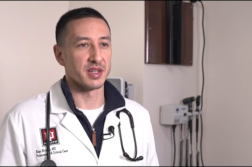SALT LAKE CITY, Utah (Ivanhoe Newswire) – Lung cancer — it’s the leading cancer killer in men and women nationally. The five-year survival rate is only about twenty percent, that’s because by the time you know you have it, the cancer has progressed. But if doctors can diagnose it earlier, the cure rate is over 90 percent. A new way to spot it and remove lung cancer is giving patients hope of surviving it.
Rodney Poche is on a mission collecting enough special coins to give to his children, grandchildren, and great grandchildren, and that adds up to quite a lot of coins!
“Six kids, 30 grandkids, eight great grand kids, and three on the way,” Rodney shares with Ivanhoe.
Rodney feels blessed for each day he has with his family. Doctors found cancer in his kidney — they removed that two years ago, then it spread to his lung.
Robotic Thoracic Surgeon at the University of Utah Huntsman Cancer Institute, Brian Mitzman, MD says, “Lung cancers are hard to detect because they usually start at just a few millimeters and you can’t see that on a chest x-ray.”
Dr. Mitzman is one of the first to use an ion robotic assisted navigation bronchoscopy to help pinpoint exactly where the cancer is.
“It’s a tiny camera that will go down the airway of the patient and go inside the patient’s lung. It takes the patient’s CT scan and builds us this 3D augmented GPS pathway and tells us exactly where to go so we could get out to where their tiny little two-millimeter nodule is. We inject a little dye into it so that when we go to do the lung resection, it glows for us,” Dr. Mitzman explains.
Rodney had a tiny cancer nodule in the upper part of his right lung — a spot Dr. Mitzman says they would never be able to see on a CT scan.
Dr. Mitzman adds, “Without this technology, we would end up having to take out a fairly large piece of his lung to make sure we got all of the cancer.”
Instead, he removed just a small piece — about the size of quarter. Rodney recovered in days instead of weeks, and he is now cancer-free, just in time for three new family members to arrive this spring.
Many other hospitals are using this technology in biopsies, but the Huntsman Cancer Institute is one of the first in the country to use this technology to mark tumors during surgery.
Contributors to this news report include: Marsha Lewis, Producer; Roque Correa, Videographer & Editor.
To receive a free weekly e-mail on medical breakthroughs from Ivanhoe, sign up at: http://www.ivanhoe.com/ftk
MEDICAL BREAKTHROUGHS
RESEARCH SUMMARY
TITLE: GRANDFATHER’S LIFESAVER! ION ROBOT TARGETS LUNG CANCER
REPORT: MB #5196
BACKGROUND: Lung cancer is a type of cancer that begins in the lungs. Your lungs are two spongy organs in your chest that take in oxygen when you inhale and release carbon dioxide when you exhale. Lung cancer is the leading cause of cancer deaths worldwide. People who smoke have the greatest risk of lung cancer, though lung cancer can also occur in people who have never smoked. The risk of lung cancer increases with the length of time and number of cigarettes you’ve smoked. If you quit smoking, even after smoking for many years, you can significantly reduce your chances of developing lung cancer. The American Cancer Society’s estimates for lung cancer in the US for 2023 are: about 238,340 new cases of lung cancer (117,550 in men and 120,790 in women) and about 127,070 deaths from lung cancer (67,160 in men and 59,910 in women).
(Sources: https://www.mayoclinic.org/diseases-conditions/lung-cancer/symptoms-causes/syc-20374620
https://www.cancer.org/cancer/lung-cancer/about/key-statistics.html)
DIAGNOSING: Lung cancer typically doesn’t cause signs and symptoms in its earliest stages. Signs and symptoms of lung cancer typically occur when the disease is advanced. Signs and symptoms of lung cancer may include: a new cough that doesn’t go away, coughing up blood, shortness of breath, chest pain, bone pain, and/or headache. If there’s reason to think that you may have lung cancer, your doctor can order a number of tests to look for cancerous cells and to rule out other conditions. Tests may include: imaging tests, sputum cytology, and/or a biopsy.
(Sources: https://www.mayoclinic.org/diseases-conditions/lung-cancer/symptoms-causes/syc-20374620
https://www.mayoclinic.org/diseases-conditions/lung-cancer/diagnosis-treatment/drc-20374627)
NEW TECHNOLOGY: A robotic-assisted endoluminal platform for minimally invasive peripheral lung biopsy, known as ION, is now in operation at Emory Saint Joseph’s Hospital. This technology diagnoses lung cancer sooner and with greater accuracy. It also substantially decreases the risk of collapsing the lung because bronchoscopy with Ion robotic assistance allows the specialist to use natural openings in the body.
FOR MORE INFORMATION ON THIS REPORT, PLEASE CONTACT:
Avery Shrader
If this story or any other Ivanhoe story has impacted your life or prompted you or someone you know to seek or change treatments, please let us know by contacting Marjorie Bekaert Thomas at mthomas@ivanhoe.com




